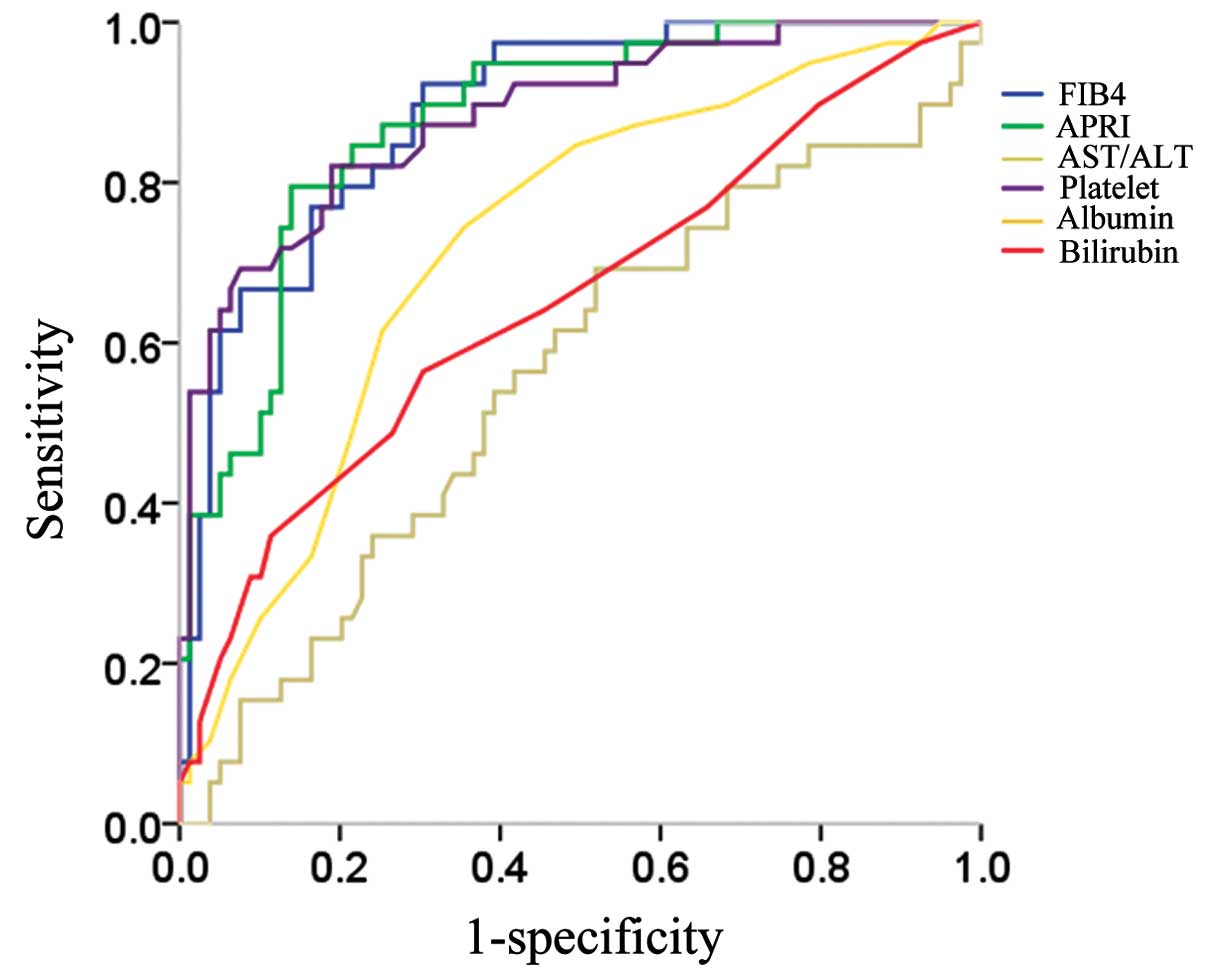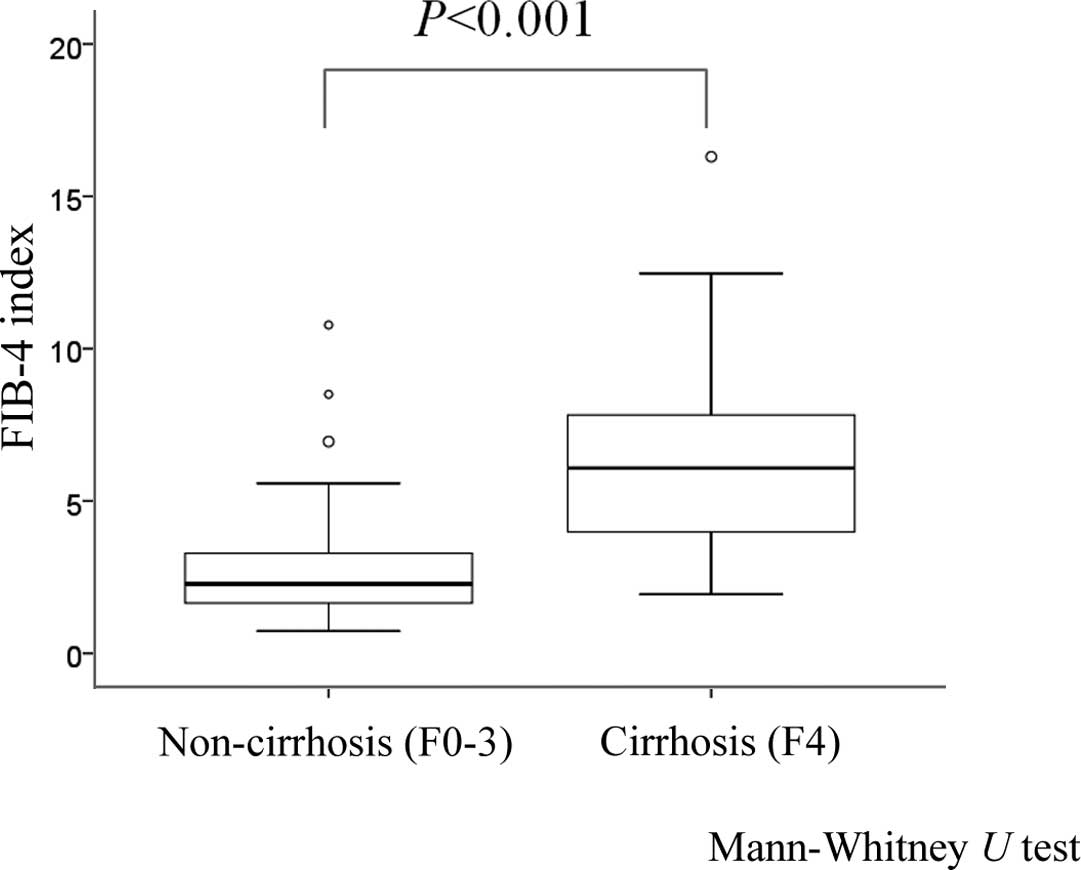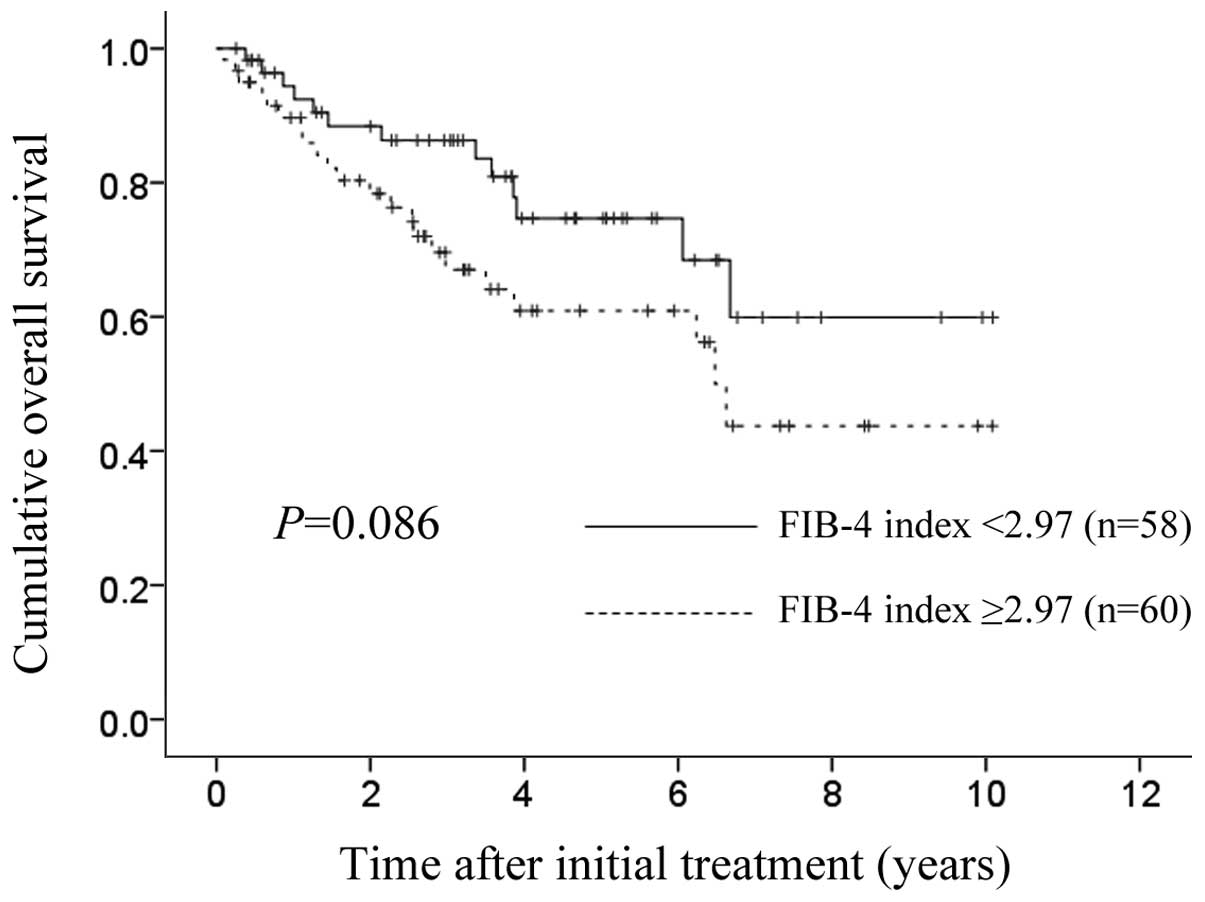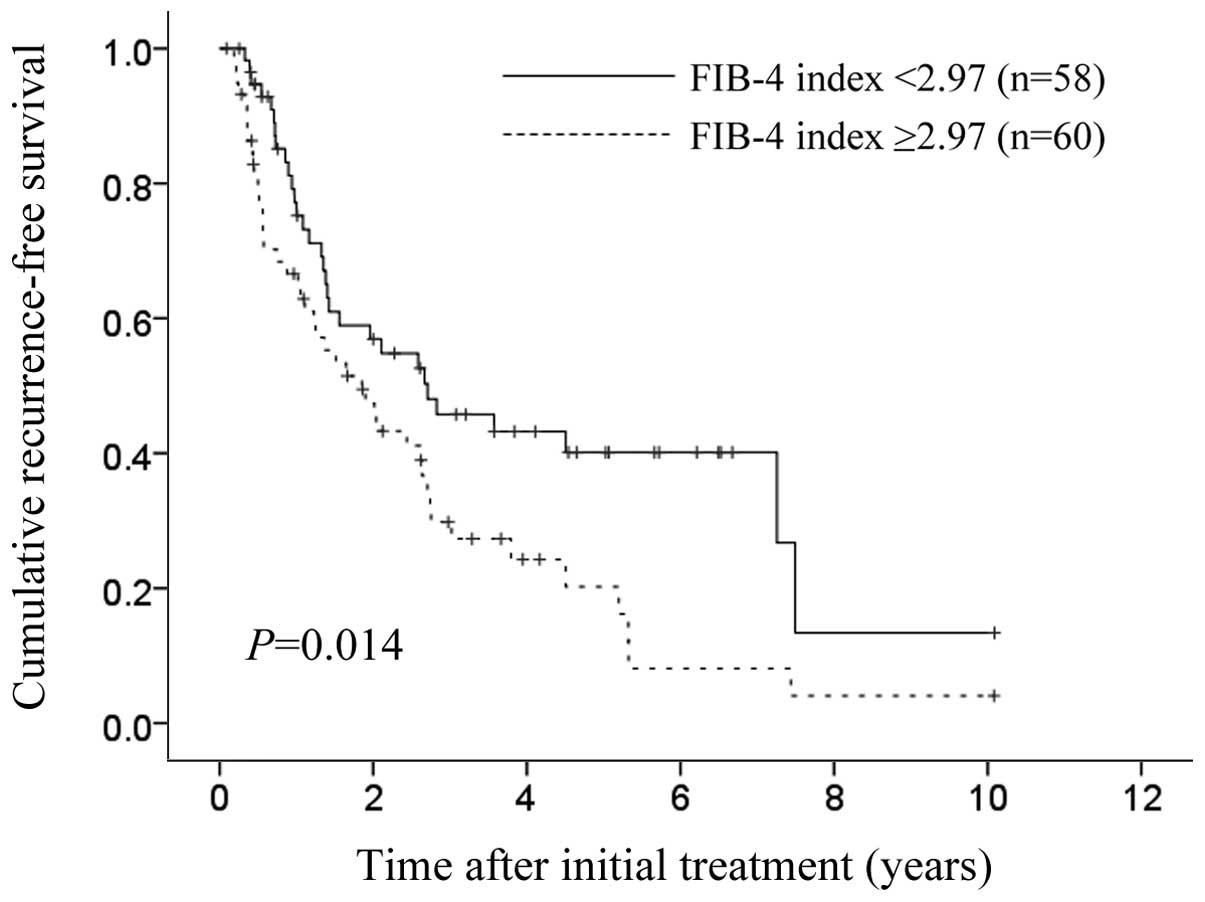|
1
|
Osaki Y and Nishikawa H: Treatment for
hepatocellular carcinoma in Japan over the last three decades: our
experience and published work review. Hepatol Res. Jun
26–2014.(Epub ahead of print). View Article : Google Scholar
|
|
2
|
El-Serag HB: Epidemiology of viral
hepatitis and hepatocellular carcinoma. Gastroenterology.
142:1264–1273. 2012. View Article : Google Scholar : PubMed/NCBI
|
|
3
|
de Lope CR, Tremosini S, Forner A, Reig M
and Bruix J: Management of HCC. J Hepatol. 56(Suppl 1): S75–S87.
2012. View Article : Google Scholar : PubMed/NCBI
|
|
4
|
Kaibori M, Ishizaki M, Matsui K and Kwon
AH: Clinicopathologic characteristics of patients with non-B non-C
hepatitis virus hepatocellular carcinoma after hepatectomy. Am J
Surg. 204:300–307. 2012. View Article : Google Scholar : PubMed/NCBI
|
|
5
|
Nishikawa H and Osaki Y: Non-B, non-C
hepatocellular carcinoma (Review). Int J Oncol. 43:1333–1342.
2013.PubMed/NCBI
|
|
6
|
Utsunomiya T and Shimada M: Molecular
characteristics of non-cancerous liver tissue in non-B non-C
hepatocellular carcinoma. Hepatol Res. 41:711–721. 2011. View Article : Google Scholar : PubMed/NCBI
|
|
7
|
Umemura T and Kiyosawa K: Epidemiology of
hepatocellular carcinoma in Japan. Hepatol Res. 37(Suppl 2):
S95–S100. 2007. View Article : Google Scholar : PubMed/NCBI
|
|
8
|
Zhou WP, Lai EC, Li AJ, Fu SY, Zhou JP,
Pan ZY, Lau WY and Wu MC: A prospective, randomized, controlled
trial of preoperative transarterial chemoembolization for
resectable large hepatocellular carcinoma. Ann Surg. 249:195–202.
2009. View Article : Google Scholar : PubMed/NCBI
|
|
9
|
Nishikawa H, Osaki Y, Kita R, Kimura T,
Inuzuka T, Takeda H, Nakajima J, Matsuda F, Sakamoto A, Henmi S,
Hatamaru K, Saito S and Nasu A: Transcatheter arterial infusion
chemotherapy prior to radiofrequency thermal ablation for single
hepatocellular carcinoma reduces the risk of intrahepatic distant
recurrence. Int J Oncol. 41:903–909. 2012.PubMed/NCBI
|
|
10
|
Nishikawa H, Osaki Y, Kita R, Kimura T,
Ohara Y, Takeda H, Sakamoto A, Saito S, Nishijima N, Nasu A,
Komekado H and Nishiguchi S: Comparison of transcatheter arterial
chemoembolization and transcatheter arterial chemotherapy infusion
for patients with intermediate-stage hepatocellular carcinoma.
Oncol Rep. 31:65–72. 2014.
|
|
11
|
Castera L: Invasive and non-invasive
methods for the assessment of fibrosis and disease progression in
chronic liver disease. Best Pract Res Clin Gastroenterol.
25:291–303. 2011. View Article : Google Scholar : PubMed/NCBI
|
|
12
|
Chrostek L and Panasiuk A: Liver fibrosis
markers in alcoholic liver disease. World J Gastroenterol.
20:8018–8023. 2014. View Article : Google Scholar : PubMed/NCBI
|
|
13
|
Sumida Y, Nakajima A and Itoh Y:
Limitations of liver biopsy and non-invasive diagnostic tests for
the diagnosis of nonalcoholic fatty liver disease/nonalcoholic
steatohepatitis. World J Gastroenterol. 20:475–485. 2014.
View Article : Google Scholar : PubMed/NCBI
|
|
14
|
Smith JO and Sterling RK: Systematic
review: non-invasive methods of fibrosis analysis in chronic
hepatitis C. Aliment Pharmacol Ther. 30:557–576. 2009. View Article : Google Scholar : PubMed/NCBI
|
|
15
|
D’Onofrio M, Crosara S, De Robertis R,
Canestrini S, Demozzi E, Gallotti A and Pozzi Mucelli R: Acoustic
radiation force impulse of the liver. World J Gastroenterol.
19:4841–4849. 2013. View Article : Google Scholar
|
|
16
|
Mariappan YK, Glaser KJ and Ehman RL:
Magnetic resonance elastography: a review. Clin Anat. 23:497–511.
2010. View
Article : Google Scholar : PubMed/NCBI
|
|
17
|
Yu ML, Lin SM, Lee CM, Dai CY, Chang WY,
Chen SC, Lee LP, Lin ZY, Hsieh MY, Wang LY, Chuang WL and Liaw YF:
A simple noninvasive index for predicting long-term outcome of
chronic hepatitis C after interferon-based therapy. Hepatology.
44:1086–1097. 2006. View Article : Google Scholar : PubMed/NCBI
|
|
18
|
Castera L: Noninvasive methods to assess
liver disease in patients with hepatitis B or C. Gastroenterology.
142:1293–1302. 2012. View Article : Google Scholar : PubMed/NCBI
|
|
19
|
Vallet-Pichard A, Mallet V, Nalpas B,
Verkarre V, Nalpas A, Dhalluin-Venier V, Fontaine H and Pol S:
FIB-4: an inexpensive and accurate marker of fibrosis in HCV
infection. Comparison with liver biopsy and fibrotest. Hepatology.
46:32–36. 2007. View Article : Google Scholar : PubMed/NCBI
|
|
20
|
Angulo P, Bugianesi E, Bjornsson ESP,
Mills PR, Barrera F, Haflidadottir S, Day CP and George J: Simple
noninvasive systems predict long-term outcomes of patients with
nonalcoholic fatty liver disease. Gastroenterology. 145:782–789.e4.
2013. View Article : Google Scholar : PubMed/NCBI
|
|
21
|
Tamaki N, Kurosaki M, Matsuda S, Muraoka
M, Yasui Y, Suzuki S, Hosokawa T, Ueda K, Tsuchiya K, Nakanishi H,
Itakura J, Takahashi Y, Asahina Y and Izumi N: Non-invasive
prediction of hepatocellular carcinoma development using serum
fibrosis marker in chronic hepatitis C patients. J Gastroenterol.
Dec 15–2013.(Epub ahead of print). PubMed/NCBI
|
|
22
|
Chon YE, Jung ES, Park JY, Kim do Y, Ahn
SH, Han KH, Chon CY, Jung KS and Kim SU: The accuracy of
noninvasive methods in predicting the development of hepatocellular
carcinoma and hepatic decompensation in patients with chronic
hepatitis B. J Clin Gastroenterol. 46:518–525. 2012. View Article : Google Scholar : PubMed/NCBI
|
|
23
|
Shen SL, Fu SJ, Chen B, Kuang M, Li SQ,
Hua YP, Liang LJ, Guo P, Hao Y and Peng BG: Preoperative aspartate
aminotransferase to platelet ratio is an independent prognostic
factor for hepatitis B-induced hepatocellular carcinoma after
hepatic resection. Ann Surg Oncol. May 22–2014.(Epub ahead of
print). View Article : Google Scholar
|
|
24
|
Hung HH, Su CW, Lai CR, Chau GY, Chan CC,
Huang YH, Huo TI, Lee PC, Kao WY, Lee SD and Wu JC: Fibrosis and
AST to platelet ratio index predict post-operative prognosis for
solitary small hepatitis B-related hepatocellular carcinoma.
Hepatol Int. 4:691–699. 2010. View Article : Google Scholar
|
|
25
|
Alberti KG and Zimmet PZ: Definition,
diagnosis and classification of diabetes mellitus and its
complications. Part 1: diagnosis and classification of diabetes
mellitus provisional report of a WHO consultation. Diabet Med.
15:539–553. 1998. View Article : Google Scholar : PubMed/NCBI
|
|
26
|
Wai CT, Greenson JK, Fontana RJ,
Kalbfleisch JD, Marrero JA, Conjeevaram HS and Lok AS: A simple
noninvasive index can predict both significant fibrosis and
cirrhosis in patients with chronic hepatitis C. Hepatology.
38:518–526. 2003. View Article : Google Scholar : PubMed/NCBI
|
|
27
|
Sterling RK, Lissen E, Clumeck N, Sola R,
Correa MC, Montaner J, Sulkowski MS, Torriani FJ, Dieterich DT,
Thomas DL, Messinger D and Nelson M: APRICOT Clinical
Investigators: Development of a simple noninvasive index to predict
significant fibrosis in patients with HIV/HCV coinfection.
Hepatology. 43:1317–1325. 2006. View Article : Google Scholar : PubMed/NCBI
|
|
28
|
Bruix J and Sherman M: Practice Guidelines
Committee, American Association for the Study of Liver Diseases:
Management of hepatocellular carcinoma. Hepatology. 42:1208–1236.
2005. View Article : Google Scholar : PubMed/NCBI
|
|
29
|
No authors listed. The general rules for
the clinical and pathological study of primary liver cancer. Liver
Cancer Study Group of Japan. Jpn J Surg. 19:98–129. 1989.
View Article : Google Scholar : PubMed/NCBI
|
|
30
|
Utsunomiya T, Shimada M, Kudo M, Ichida T,
Matsui O, Izumi N, Matsuyama Y, Sakamoto M, Nakashima O, Ku Y,
Takayama T and Kokudo N; for the Liver Cancer Study Group of Japan.
A Comparison of the surgical outcomes among patients with
HBV-positive, HCV-positive, and non-B non-C hepatocellular
carcinoma: a nationwide study of 11,950 patients. Ann Surg. Jul
28–2014.(Epub ahead of print). View Article : Google Scholar : PubMed/NCBI
|
|
31
|
Nalbantoglu I and Brunt EM: Role of liver
biopsy in nonalcoholic fatty liver disease. World J Gastroenterol.
20:9026–9037. 2014.PubMed/NCBI
|
|
32
|
Wang C, Wang X, Gong G, Ben Q, Qiu W, Chen
Y, Li G and Wang L: Increased risk of hepatocellular carcinoma in
patients with diabetes mellitus: a systematic review and
meta-analysis of cohort studies. Int J Cancer. 130:1639–1648. 2012.
View Article : Google Scholar
|
|
33
|
Calle EE, Rodriguez C, Walker-Thurmond K
and Thun MJ: Overweight, obesity, and mortality from cancer in a
prospectively studied cohort of U.S. adults. N Engl J Med.
348:1625–1638. 2003. View Article : Google Scholar : PubMed/NCBI
|
|
34
|
Nishikawa H and Osaki Y: Clinical
significance of therapy using branched-chain amino acid granules in
patients with liver cirrhosis and hepatocellular carcinoma. Hepatol
Res. 44:149–158. 2014. View Article : Google Scholar
|
|
35
|
Jung KS, Kim SU, Choi GH, Park JY, Park
YN, Kim do Y, Ahn SH, Chon CY, Kim KS, Choi EH, Choi JS and Han KH:
Prediction of recurrence after curative resection of hepatocellular
carcinoma using liver stiffness measurement
(FibroScan®). Ann Surg Oncol. 19:4278–4286. 2012.
View Article : Google Scholar : PubMed/NCBI
|
|
36
|
Imamura H, Matsuyama Y, Tanaka E, Ohkubo
T, Hasegawa K, Miyagawa S, Sugawara Y, Minagawa M, Takayama T,
Kawasaki S and Makuuchi M: Risk factors contributing to early and
late phase intrahepatic recurrence of hepatocellular carcinoma
after hepatectomy. J Hepatol. 38:200–207. 2003. View Article : Google Scholar : PubMed/NCBI
|
|
37
|
McCurry J: Japan battles with obesity.
Lancet. 369:451–452. 2007. View Article : Google Scholar : PubMed/NCBI
|
|
38
|
Examination Committee of Criteria for
‘Obesity Disease’ in Japan; Japan Society for the Study of Obesity.
New criteria for ‘Obesity Disease’ in Japan. Circ J. 66:987–992.
2002. View Article : Google Scholar
|


















